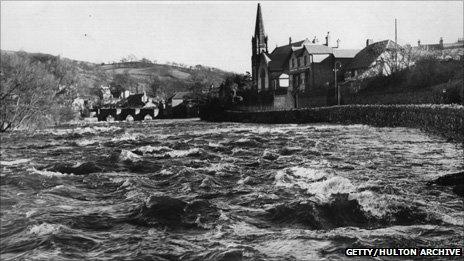Dee and Taff in Environment Agency improved rivers list
- Published

The Taff was once 'lifeless'
The River Dee and the River Taff have been named in an Environment Agency top 10 list of most improved rivers in England and Wales.
The Taff, in south Wales, has recovered from a "lifeless river" to become a popular angling destination.
And the water quality of the Dee, which flows for 70 miles through Wales and England, has benefited from stricter rules on industrial pollution.
But the Environment Agency said there is "still more to be done".
The agency's list praised the waterways in England and Wales that have shrugged off their industrial past to become havens for wildlife, walkers and anglers.
And it urged members of the public to walk along their local rivers to see the regeneration for themselves.
The transformation of the rivers has been achieved through "habitat improvement projects, tighter regulation of polluting industries and work with farmers, businesses and water companies to reduce pollution and improve water quality".
River habitats have also benefited from reductions in the volume of water taken by water companies, farmers and industry.
No life
Ian Barker, head of land and water at the Environment Agency, said: "Britain's rivers are the healthiest for over 20 years and otters, salmon and other wildlife are returning for the first time since the industrial revolution.
"But there is still more to be done, and we have plans to transform a further 9,500 miles of rivers in England and Wales by 2015 - the equivalent of the distance between the UK and Australia."
As recently as the 1980s, the rivers of south Wales were so polluted that no life could survive.
But 30 years on, following the closure of the coal mines and work by environmental groups, the Taff is now home to many species of wildlife, including salmon, otters, sea trout and eels.
The water quality has dramatically improved, after the introduction of tighter controls on industrial discharges, and improvements in sewage treatment processes.
The River Dee, also known as Afon Dyfrdwy, rises in Snowdonia and forms part of the border between Wales and England. It is one of the biggest single sources of water supply in the UK.
It is also an important natural fishery, and its stocks of salmon and trout prove a magnet for many angling clubs.
During the winter, more than 100,000 waders and 20,000 water fowl make the River Dee their home.
Improved water quality has led to the development of the Dee Estuary, which is now home to a sustainable cockle industry.
Strict conditions on commercial discharges from industrialised areas into the River Dee has reduced pollution from toxic chemicals.
David Leigh of the Environment Agency told BBC Wales: "There have been parts that have been polluted in the past with chemicals.
"We've been regulating industries and making sure that what they do doesn't harm the environment and wildlife.
"There's been lots of efforts made over many years to improve water quality.
"One of the things we were able to do on the Dee was to put in a protection zone...it gave us powers to ensure that operators that were on the Dee above the weir were able to store chemicals correctly and to make sure that what they stored was correctly disposed of."
The Environment Agency has reviewed thousands of abstraction licences and is now amending those causing environmental damage.

Restrictions have reduced pollution in the River Dee in recent decades
- Published30 August 2011
- Published21 May 2011